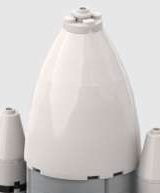|
|
NASA Space Shuttle Program – 40th anniversary of STS-1 |
|

|

|

|

|

|

|
 ) of the ET for STS-1 are currently only available in the colors Light Bluish Gray, Black, Dark Orange, Bright Light Orange and Dark Blue. So these must be colored manually.
) of the ET for STS-1 are currently only available in the colors Light Bluish Gray, Black, Dark Orange, Bright Light Orange and Dark Blue. So these must be colored manually.

|

|